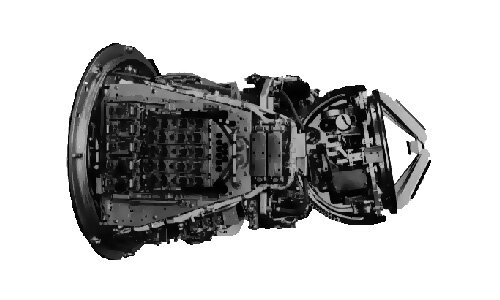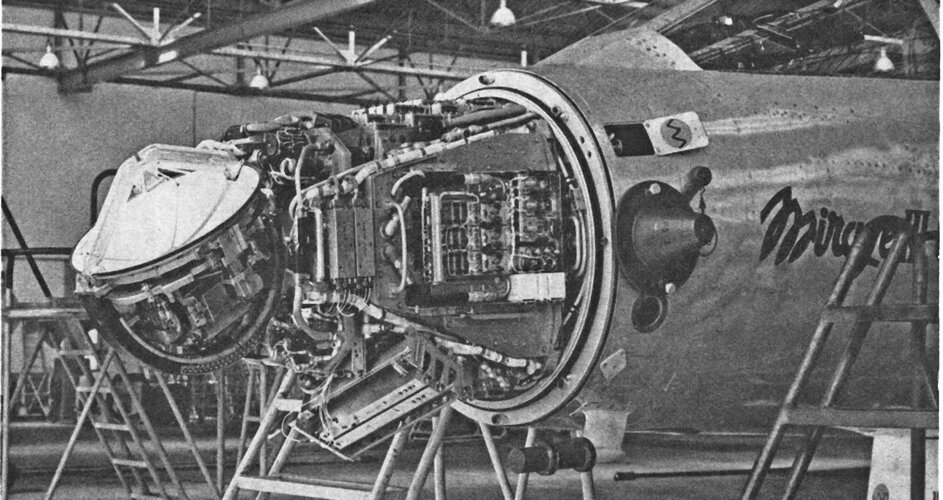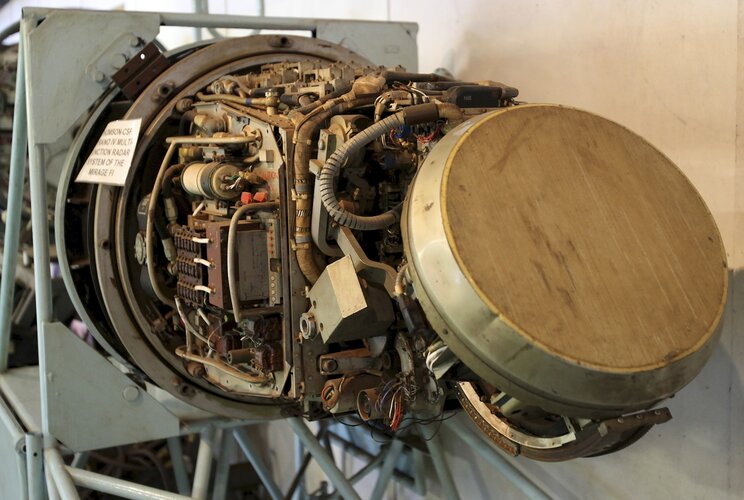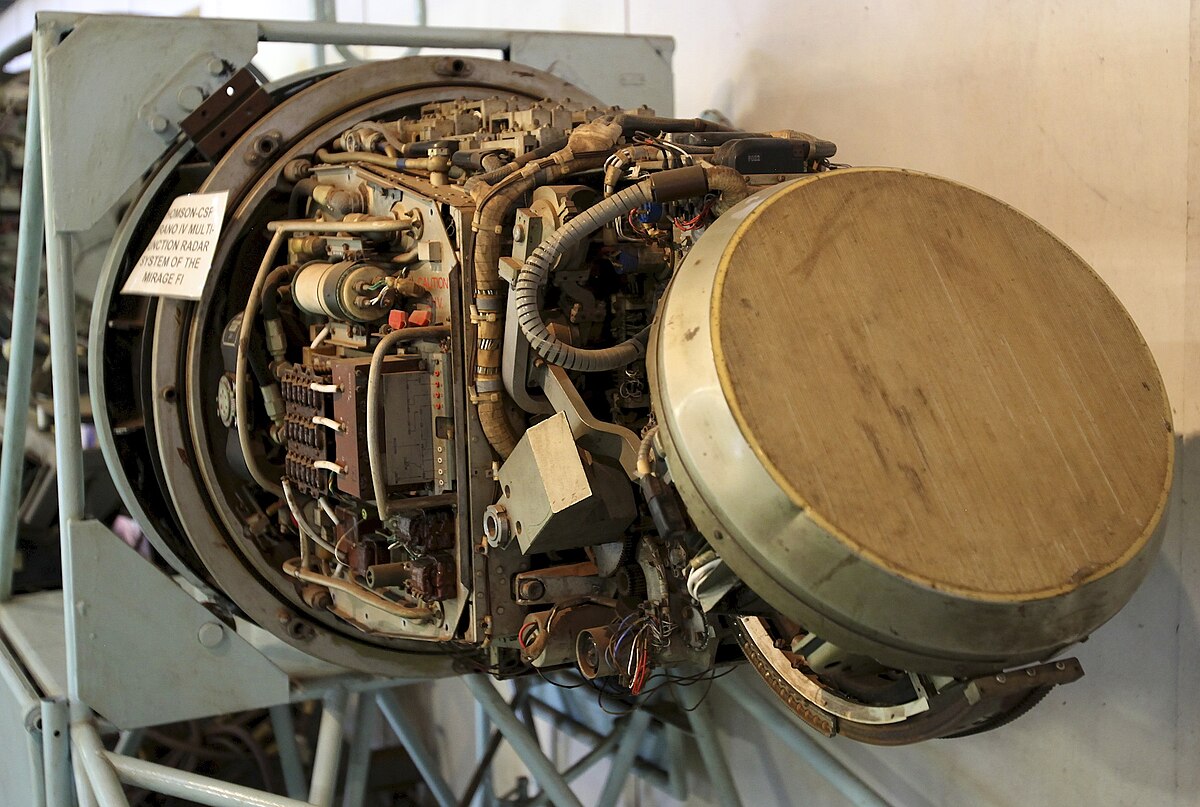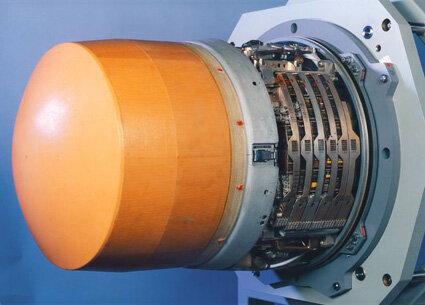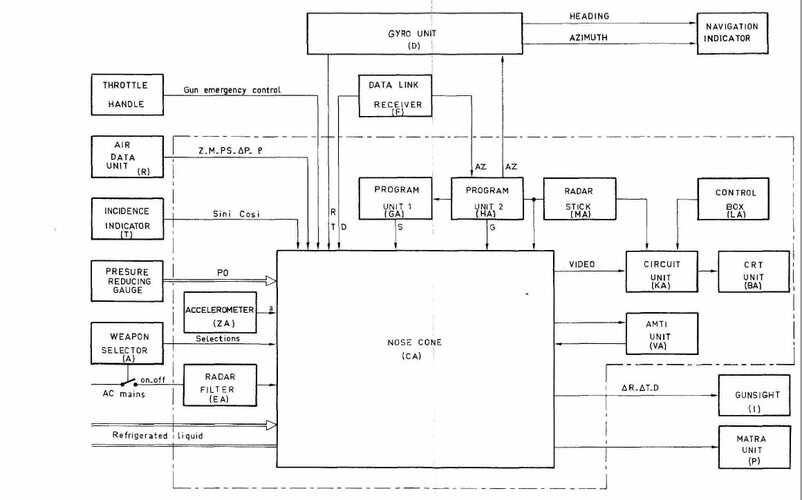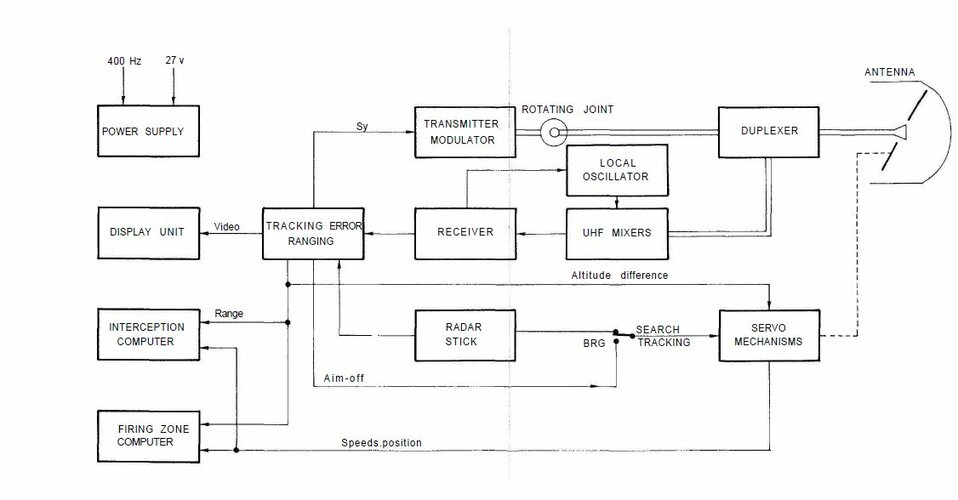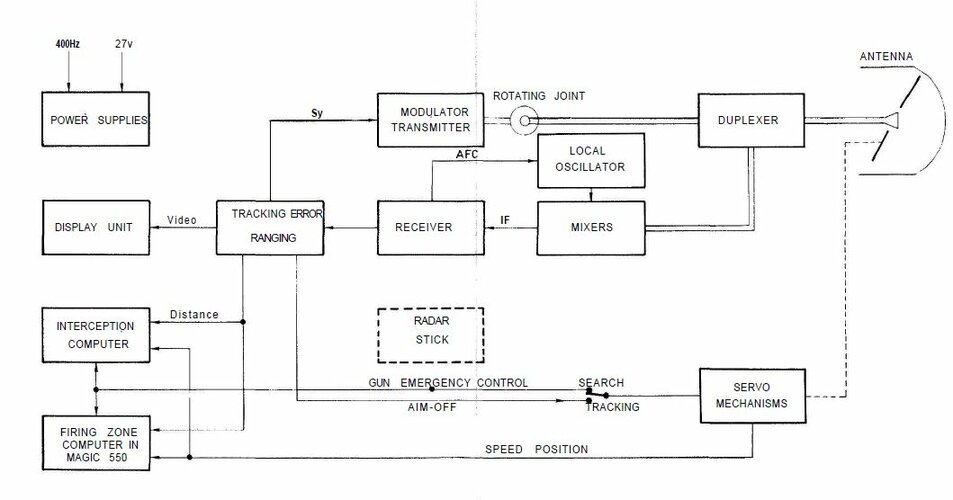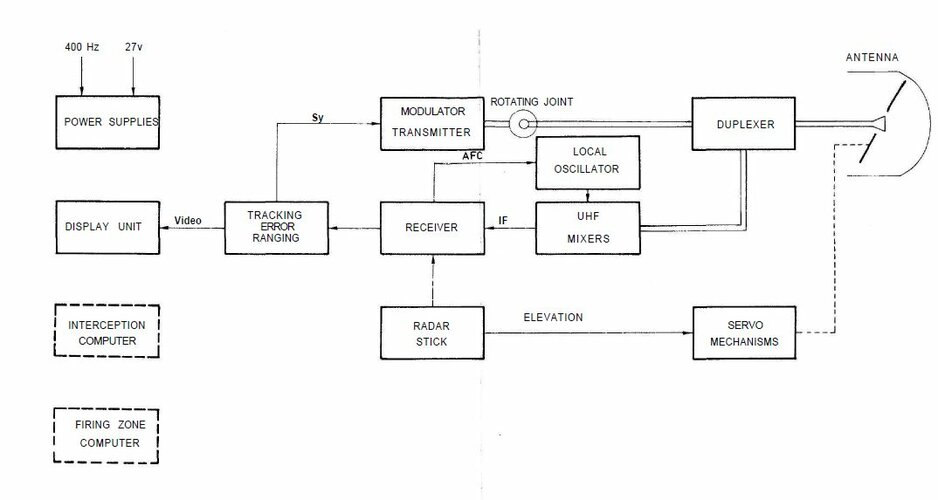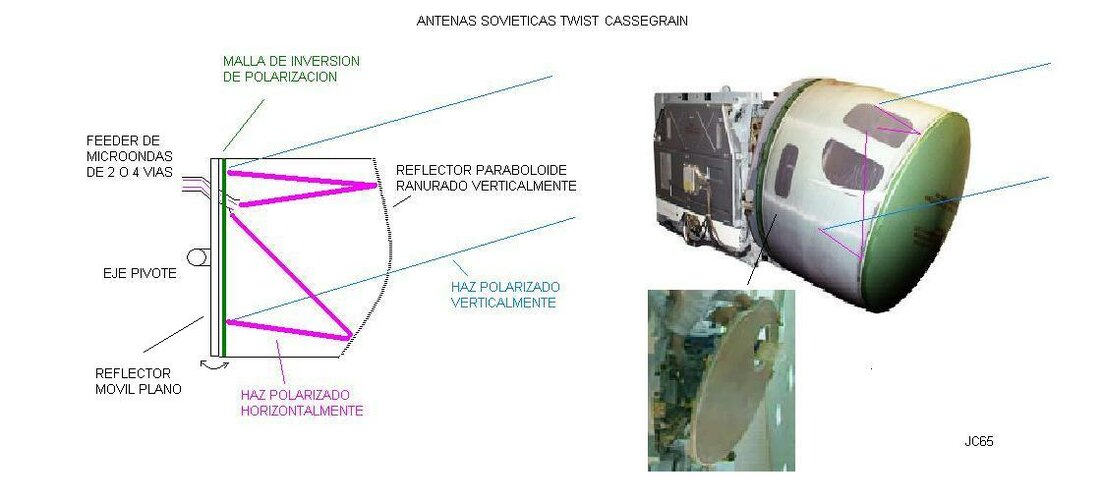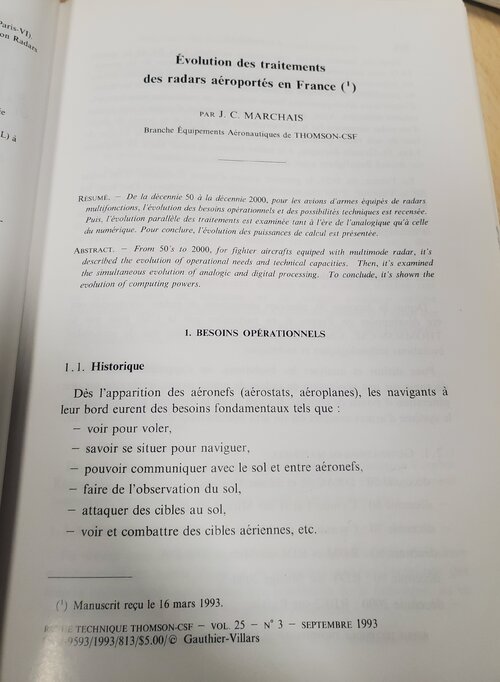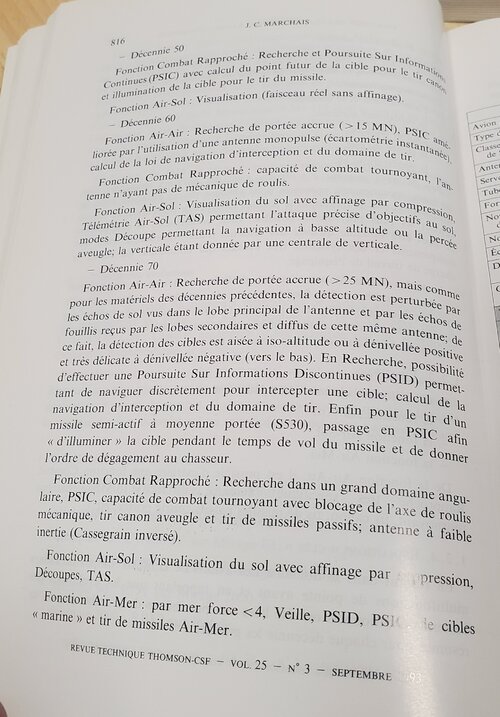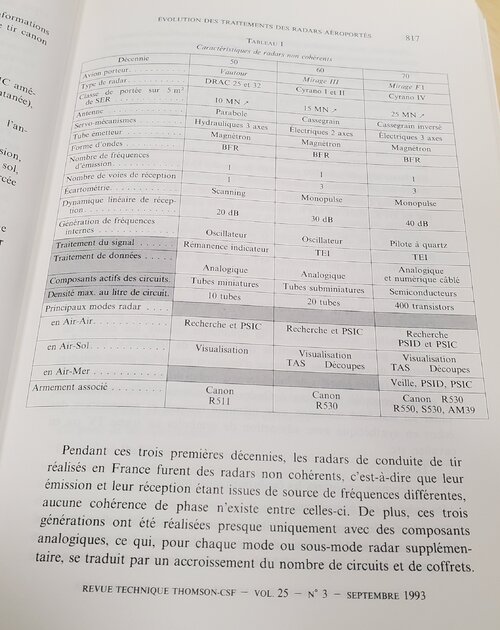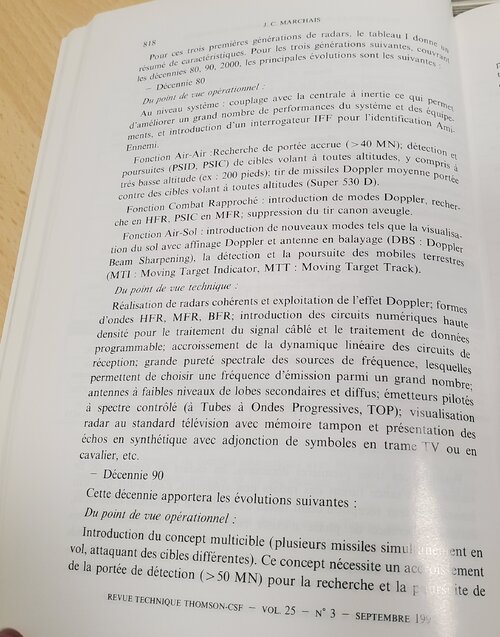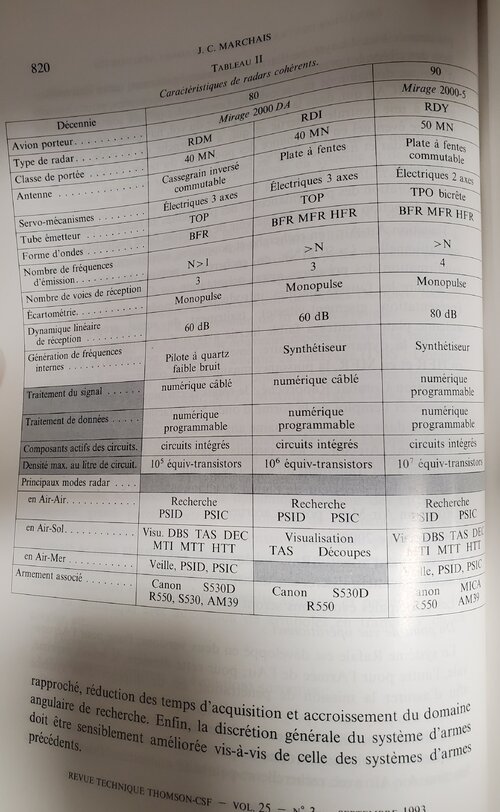SECOND GENERATION AIR-TO-AIR MISSILES
Compared to the first period (see chapter 4), the threat had changed. With the adoption of fighter-bombers, the fighter's superiority in maneuver over the bomber disappeared, and with it the "ease" of kinematic interception in the rear sector. The interceptor was therefore required to be able to fire in all sectors, and if possible with a difference in altitude; in addition, the target's maneuvering capabilities were no longer as weak. In 1957, the STAé/ES consulted the two missile manufacturers on the future air-to-air missile intended to arm the Mirage III; two program sheets, published on December 19, 1957 by the EMAA, coexisted: AA 25 remote guidance and AA 26 autoguidance.
North 5104 (AA 25)
Given its experience, Nord-Aviation chose the AA 25 file and submitted the Nord 5104 project at the beginning of 1958. Its development began in September 1958.
The difference with the Nord 5103 was in the automatic remote control, whose fire control of the aircraft was to ensure the development of the guidance order. This fire control was to include an on-board radar with two reception chains, an additional system for the missile support and an associated computer. The main difficulties in developing the system were carried over to the fire control, which was difficult to achieve, at the end of the 1950s, with the level of technical knowledge (the level of ground echoes detected by the airborne radar was poorly known) and with the available technology.
The choice of the missile for the Mirage III was made in October 1959 and it fell on the competing program, AA 26 (the reasons for this choice were mentioned above). This marked the end of the Nord 5104 and the use of remote control for air-to-air.
R 530 (AA 26) – Matra
Matra decided to respond to the AA 26 sheet with the R 530 project, submitted in April 1958. We have seen that Matra had chosen the path of self-guidance and that in 1957, it completed the development of the R 511, self-guided in pursuit.
The R 530 took into account information gathered during missions in the United States in 1958; it was the complete project of a self-guided missile following the proportional navigation law. It included two versions, electromagnetic (EM) and infrared (IR), differing only in the homing device. This project involved several technical and technological challenges.
As with the Nord 5104, development of the R 530 began in September 1958 and its choice for the armament of the Mirage III, in October 1959, launched it definitively.
During these three years, from 1958 to 1960, with the support of the STAé, Matra and its cooperators, EMD, SAT and TRT, succeeded in bringing the R 530 up to the level of the American industry and even innovating by winning the following technical and technological challenges:
- have a thorough knowledge of the proportional navigation self-guidance law, to optimize guidance; this was a successful study by Matra;
- to produce an electromagnetic homing device with a stabilized aerial; we indicated in chapter 8 that the EMD company had started the study at the beginning of 1959 (in competition with CFTH) and that at the beginning of 1960, it presented a prototype comprising a gyroscopic head and transistorized electronics. Then, in one year, both the production by EMD of AD prototypes capable of equipping a missile, from the point of view of environmental resistance, the flight tests of the homing device with the Cyrano scout radar and the first successful firing of the R 530 EM self-guided missile were carried out;
- to produce an infrared homing device with a gyroscopic head; we have indicated (chapter 8) that the SAT had developed, during these three years, on the one hand the infrared components valid in band 2 (irdome, detector and cooler), and on the other hand the homing device. The first shot took place in September 1961 with an impact on the target;
- to produce an electromagnetic proximity rocket in X-band, with flat directional antennas and without untimely triggering; we indicated (chapter 8) that TRT had presented such a project. The prototypes were produced and successfully tested in two years. The only defect of this rocket was the maintenance of the subminiature tube technology.
The missile's characteristics and performance are as follows:
- mass of 196 kg;
- 263 mm diameter; classic, cruciform configuration;
- solid propellant (plastolite) booster with two thrust levels;
- pitch and yaw control with gyrometer stabilization; roll control, to limit rotation speed; electric servomotors;
- proximity and impact fuse; 30 kg fragmentation charge;
- two interchangeable homing devices (AD): semi-active electromagnetic with pulses and scanning and infrared in band 2 (“all sectors”); gyroscopic heads with a range of ± 45° and pre-positioned, at the start, on the target by information from the on-board radar; hemispherical radome;
- performance: maximum firing distance, in frontal attack, limited by the range of the AD (10 km); maximum height difference of 3,000 m; range of use at altitude: from 3,000 m (ground echoes) to 18,000 m; reduced passing distances (4 m on average);
- more reliable and more precise IR version, with many impacts; but it was little used by French operational personnel, given the hassle of filling the AD's liquid nitrogen tank.
The development was carried out quickly:
- in-flight development (50 shots of the EM version and 25 shots of the IR version) in two years: 1961 and 1962;
- assessment in 1963;
- first series delivery in April 1964, in accordance with the schedule established in 1959.
Between 1964 and 1980, 2,300 missiles were produced, including 1,200 for export linked to the Mirage III, to Israel, Australia, Libya, Pakistan, etc. The missile equipped the Mirage III, the Crusader for the Navy (adaptation to the radar and the aircraft was carried out without any difficulty, with flight tests in the United States and France) and the Mirage F1, while waiting for the Super 530, put into service in 1979.
It underwent a redesign phase at the end of the 1970s, with the replacement of obsolete components: propellant (isolite instead of plastolite), homing devices, transistorization of the retarder.
The competitive situation until the end of the 1970s
In the West, there were only two design countries, the United States and France, and two exportable all-weather interceptor weapon systems: the Mirage III-R 530 and the Phantom-Sparrow III. We will only compare the performance of the missiles. The aircraft had differences: the Phantom was heavier, more expensive, and carried four Sparrows instead of one for the Mirage III; the larger size of the Phantom's radar antenna resulted in a greater range for the Sparrow's AD EM.
The first version, 7 C, of the Sparrow III, briefly described in Chapter 4, was put into service in 1960; it was quickly replaced, in 1963, by an improved version, 7 E. The characteristics and performances of these first versions of the Sparrow are close to those of the R 530, except on the following major points:
- to the Sparrow's credit: a semi-active Doppler homing system (requires an on-board radar with a continuous illuminator), which allowed it to fire on low-altitude targets, and a movable wing configuration, which allowed it to have a streamlined radome 5 .
- to the R 530's advantage: an interchangeable infrared version, which was a fundamental advantage from the point of view of combating jamming; transistorized ADs, whereas the Sparrow's technology was that of 1956 (tubes), hence a difference in reliability; and electric rather than hydraulic servomotors (for controlling the wings), technologically simplifying the missile.
Production of these versions, until 1980, was 35,000 copies. The Phantom-Sparrow system (the missile is linked to the on-board radar) was little exported, except to Great Britain. Countries like Germany, not having such a weapon system, could only rely on their ground-to-air batteries or on the American NATO Air Forces.
5 A difficulty of the missiles of the time was the possibility of destabilization of the missile at altitude due to aberrations of the radome. The solution, for the R 530, was the choice of a hemispherical radome (hence a very reduced aberration), and for the Sparrow the choice of the mobile wing (hence a greater tolerance of aberrations), hence the choice of a profiled radome. The drag of the R 530 was higher, while the Sparrow had more complex piloting equipment.
The 9B version of the infrared Sidewinder, described in Chapter 4, was a first-generation missile, put into service in 1956 and used from 1958. Not being equipped with an all-weather interception system, most Western countries armed their combat aircraft with this missile; adaptation was facilitated by the absence of a connection with the fire control system and the possible mounting at the end of the wing (70 kg). But its interception capabilities were very limited, because it had to be fired in rear attack and without pre-positioning by the radar and it was equipped with an AD in band 1 (hence many parasitic echoes).
80,000 copies of this 9 B version were manufactured, including for export, from 1956 to the end of the 1960s. Within the framework of NATO and an American license, European production (Germany, Great Britain, Italy, Norway) was undertaken under the supervision of the German company BGT; 15,000 Sidewinders of a 9 B version improved by BGT (reliability and attachment to parasitic targets) were produced from 1967. France, which had received free Sidewinders in 1960 to arm its F 86 and F 100 aircraft, bought missiles while waiting for the Magic to enter service; the latter armed its aircraft, without on-board radar, these missiles being arranged at the end of the wing. The Soviets copied the Sidewinder 9 B by producing the Atoll, and the Chinese copied the Atoll. Ultimately, almost every country used this type of missile.
From 1965, the Americans began to study the second generation of the Sidewinder, improving the 9 B version; the 9 E and 9 J versions, for the Air Force, and 9 D/9 G/9 H, for the Navy, were studied and some were produced. They offered a pre-positioning possibility and an improvement of the homing system, as well as an increase in the mass of the charge and the missile (10.4 kg and 86 kg) and an increased range. The most modern version, 9 H, was put into service in 1973: it was the first transistorized version (which was true since 1964 for the R 530), but the AD was still in band 1. 11,000 examples of these versions, mostly the 9 H, were produced.
As for the British, they produced the second generation infrared missile Red Top, in band 2, very close to the R 530 IR, but without an EM version (hence the purchase of the Sparrow); its success was reduced.
Ultimately, the Mirage III armed with the R 530 allowed France to be the only Western country to compete with the Americans in all-weather air-to-air interception capabilities. The R 530 was innovative, compared to the Americans, by having an interchangeable infrared version; in addition, this version, being in band 2, allowed "all-sector" attack and was not sensitive to infrared parasitic echoes from the ground.
THIRD GENERATION AIR-TO-AIR MISSILES
In the late 1960s, a change in missions emerged that required a change in missiles, called "third generation missiles"; there were two reasons for this.
On the one hand, both air systems had been used in combat on "exotic" terrain: the R 530 by the Israelis, from 1965 to 1967, and the Sparrow and the Sidewinder in Vietnam, from 1964 to 1973. These were not interception missions over friendly territory, equipped with a coordinated air defense system (like STRIDA in France) that guided the planes to the area where they would be able to detect the targets and then assigned each plane its targets: these were "local" conflicts, for which the missiles had not been designed. They had shown their inability to fight close combat (minimum firing distance of the order of 1,000 m).
On the other hand, the performance of the threats had evolved: high altitude (above 20,000 m) and high speed (Mach 2.5) with the Mig 25; low altitude with terrain following.
The need for two categories of air-to-air missiles arose:
- the close combat and self-protection missile: it must be capable of autonomously acquiring the target in a wide search field and of being fired without any limitation of incidence or of the load factor of the firing aircraft and at short distance (300 m); its load factor capacities must be very high, to counter the maneuvers of targets that can reach 9 g (dogfight ) ; for acquisition, the missile can be assisted by an optronic device having the adequate performances and equipping the aircraft;
- the medium-range or interception missile: compared to second-generation missiles, it must have much greater elevation (upwards and downwards) capabilities, hence an increase in motorization and firing ranges; this missile must be capable of attacking targets at low altitude, hence a Doppler-selective homing system, and of combating target jamming, which is becoming more sophisticated.
Close combat and self-protection missiles
The French family, Magic, was developed by Matra (see figures 40, 42 and 43).
Magic 1 is the world's first missile designed for close combat. We have already indicated, in Chapter 8, that its definition resulted from the needs of the Air Force, highlighted during the air operations conducted by the Israelis with the Mirage III J equipped with the R 530. This missile includes two main innovations.
On the one hand, the autonomous acquisition of the target in a large field, of the order of ± 40° (absence of on-board radar or unattached radar). It is ensured by the autodirector, in a clever way: unlike the gyroscopic head, there is separation between the antenna stabilization gyroscope (proportional navigation) and the optical infrared detection system, mounted on gimbals. For the search, the detector is decoupled from the gyroscope 6 and the scanning speed can reach 300°/s; during the shot, the axis of the detector is slaved to the direction of the axis of the gyroscope top, itself being slaved to the direction of the target.
On the other hand, firing is possible without limitation of the aircraft load factor, at a minimum firing distance of 300 m and on moving targets: we have a very manoeuvrable missile (35 g per plane) with a very reduced guidance time constant.
Its main features are:
- infrared autoguiding in band 2; but, with a single-cell detector (1970 technology), the reduced range of the AD led to the limitation of the shot to the rear domain;
- interchangeability at the level of attachment to the aircraft with the Sidewinder: vehicle of similar mass (89 kg); specific missile launcher of the Magic, including the search control electronics and the dry nitrogen bottle for cooling the cell (see chapter 8, SAT);
- canard configuration, with two original features: "double canard" comprising a fixed tail followed by a mobile control surface (high maneuverability); and only the fuselage of the missile is roll-stabilized (auto-rotating wing, as for the Matra R 422), to counter the difficulty of roll stabilization of the canard;
- Matra infrared proximity rocket; 12 kg fragmentation charge;
- performance in the firing range in the rear zone of the target: range from 300 m to 4,000 m and altitude from 50 m to 12,000 m; strong acceleration at the start: speed increase of approximately Mach 1.5.
The Magic 2 is the improved version, following technological advances; the changes were as follows:
- increased sensitivity of the infrared AD, by adopting a multi-element detector, which allowed detection of targets in frontal attack with a range such (at least 4.5 km) that the Magic 2 is "all sectors";
- improved AD for resistance to infrared decoys used after 1980;
- adoption of an “all sectors” proximity fuse (electromagnetic TRT fuse);
- partially digitized electronics;
- increased thruster impulse thanks to the adoption of cast-bonded butalane propellant;
- increased altitude range, thanks to the adoption of pitch and yaw stabilization gyrometers.
The Magic 1 was developed from 1969 and put into service in 1975, while the Magic 2, developed from 1978, was put into service in 1986. 11,000 missiles were produced, including 7,000 Magic 1s. The French order was for 3,700, with roughly the same quantity for the 1 and 2. The missile was exported to 18 countries – Greece, the Middle East (Libya, Iraq, Egypt, Kuwait, etc.), South America and Asia (Taiwan, etc.) – and it was copied in China and South Africa.
6 The gyroscopic head, having a limited precession speed, cannot perform a search; a fast search requires a large bandwidth for the detector, hence a significant reduction in its range.
It was used in several conflicts, including the Iraq-Iran War and the Gulf War. It equipped (or equipped, in 1995) many aircraft, particularly at the wingtip: Mirage III, Mirage 50, Mirage F1, Jaguar (above the wing for the British version), Crusader, Étendard and Super Étendard, Mirage 2000, Rafale, Sea Harrier, Hawk, F 16, Mig 21 and 23 (in Iraq). The Mirage 2000-Magic 2 pair was considered, in combat, to be the best in the world.
The Americans, at the same time, improved the Sidewinder and developed the 9 L version from 1971, which entered service in 1978, and then the 9 M version, which entered service in 1983, while denying the need for close combat missiles.
The Sidewinder 9 L differs mainly from the last version of the second generation, the 9 H, by the adoption of band 2 for the AD, hence a possibility of firing "all sectors" (remember that it was in 1964 that the R 530 equipped with an AD in band 2 was put into service), by an improvement in aerodynamics (shape and surface of the control surface), to increase maneuverability, and by an active laser fuze.
But this missile was inferior in maneuverability to the Magic and it required target acquisition by a means external to the missile (important difference with the Magic); it was necessary to wait for the development of the helmet sight to use the 9 L in close combat. The AD also had a resistance to decoys inferior to that of the Magic 2.
The Sidewinder 9 M, for its part, is distinguished by the adoption of a closed-cycle cooler and a low-smoke propellant (ahead of French technology on both points).
In the United States, for these 9 L and 9 M versions, 35,000 units were manufactured, production being stopped in 1991. For all versions of the Sidewinder, 126,000 units were produced, including 53,000 for export, excluding production under license. A production in Europe of the 9 L version (Germany, Great Britain, Norway, Italy, etc.), under license, of 15,000 units was carried out under the supervision of BGT, in the 1980s, which represents the equivalent of the production of the 9 B indicated above. Japan also acquired the license for the 9 L.
Medium-range or interceptor missiles
The French Super 530 family was developed by Matra (see Figures 40 and 41). The R 530 missile required a complete overhaul to adapt it to the changing threats described above.
The Super 530 F is a new missile. It has kept, from the R 530, only the diameter (263 mm) and the interchangeability with the missile launcher. This diameter was adapted to the technology of the R 530 (dating from 1958). A diameter of 220 mm would have been more rational for the Super 530, but the EMAA judged that a derivative retaining the diameter reduced the cost of development.
The Super 530 F was developed from 1969 to be adapted to the Mirage F1 7. Its main characteristics and performances are as follows:
- EM semi-active pulsed homing system: we have indicated above (chapter 8, EMD) the reasons which led to the choice, for the F1, of an on-board radar without continuous illuminator; the attack of low-altitude targets was not possible. On the other hand, the AD was modern (monopulse antenna, profiled radome and electronic technology of 1970) and its range was double that of the R 530 (gains of the radar and AD antennas significantly increased);
- classic configuration, but with reduced wing span (0.64 m, instead of 1.1 m for the R 530) to facilitate mounting under the aircraft;
- mass of 245 kg;
- more efficient propellant than the R 530: mass of 115 kg (+ 49 kg) and use of butalane as propellant;
- Thomson proximity fuze, electromagnetic correlation (see chapter 8, CFTH), and 32 kg Brandt fragmentation charge;
- performance: firing in the F1 range with maximum Mach of 4.5 for the missile; possible elevation of 9,000 m, allowing the attack of targets at 21,000 m; minimum altitude limited by the AD, varying from 1,000 m in rear attack to 3,000 m in frontal attack; maximum firing distance of 25 km; minimum firing distance of 1,000 m.
This missile was put into service in 1979; its development had been staggered for budgetary reasons. It should be noted that a few test interceptions took place at the CEL in 1975, with a height difference of 8,000 m on an American supersonic target AQM 37 A flying at a Mach 0.9 higher than the service aircraft firing it (Vautour).
In addition to the F1, the Super 530 F was adapted to the first Mirage 2000 equipped with an RDM pulse radar. 1,200 missiles were produced until 1988: 650 for France and 550 for export with the F1, to Iraq, Kuwait, Jordan and Qatar. The Super 530 F was used in the Iraq-Iran conflict.


